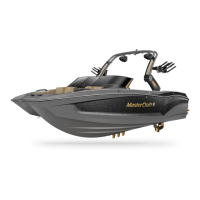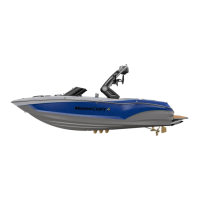Anchoring
Anchoring is done for two principal reasons: first, to stop for fishing, swimming,
lunch or an overnight stay, and secondly, to keep a boat from running aground in bad
weather or as a result of engine failure.
When preparing to anchor, bring the bow of the vessel into the wind or current.
Place the engine in neutral. When the boat comes to a stop, slowly lower the anchor.
Do not throw the anchor over as it will tend to foul the anchor or tangle line. When the
anchor line has been let out, back down on the anchor with the engine in idle reverse to
help set the anchor. After it is firmly set, use reference points (landmarks) in relation to
the boat to be sure that the boat is not drifting. Check the points frequently.
Communications
The following applies to salt water boating:
When boating o-shore, carry communications gear such as a marine VHF-FM
and/or HF transceiver(s), appropriate to the operating area. Cellular phone coverage is
available in many coastal areas. However, cellular phones should NOT be considered a
substitute for VHF-FM marine band radios for emergency purposes.
In distress situations, press the VHF transmit button and clearly say: MAYDAY,
MAYDAY, MAYDAY. Follow this with the vessel name and/or description, the location,
nature of emergency and number of people on-board. Then release the transmit button
and wait for 10 seconds. If there is no response, repeat the MAYDAY call.
Satellite EPIRBs (406 MHz) are designed to quickly and reliably alert rescue
forces, indicate an accurate distress position, and guide rescue units to the distress
scene, even when all other communications fail.
When activated, the satellite EPIRB transmits a distress signal with a beacon-
unique identifying code. The system detects the signal, calculates an accurate distress
position, checks the unique identifying code against the EPIRB registration database
(vessel and point of contact information supplied by the owner) and routes the distress
alert with registration information to the responsible U.S. Coast Guard (or International)
Rescue Coordination Center (RCC). 406MHz EPIRBs with GPS (internal or attached)
also provide an immediate GPS position in the information passed to the RCC.
Geostationary satellites make detection almost immediate. If the EPIRB does not
have the ability to provide a GPS position, the process to determine a position takes about
an hour on average and almost always less than two hours. Satellite EPIRBs also include a
homing beacon and strobe to help rescue forces quickly locate the distress scene.
Satellite beacons have significant coverage, alerting timeliness, position accuracy,
and signaling advantages over other types of EPIRBs (121.5 MHz). Before purchasing or
2013 MasterCraft Owners Manual • Safety Knowledge • Page 1-18

